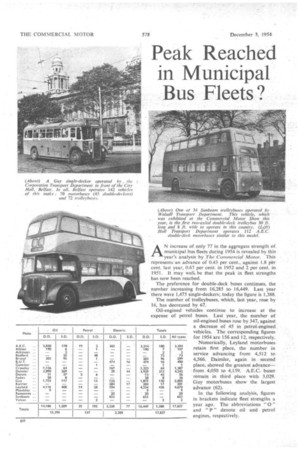Peak Reached
Page 48

If you've noticed an error in this article please click here to report it so we can fix it.
in Municipal• Bus Fleets..?.
AN increase of only 77 in the aggregate strength of municipal bus fleets during 1954 is revealed by this year's analysis by 'The Commercial Motor. This represents an advance of 0.43 per cent., against 1.8 per cent. last year, 0.67 per cent, in 1952 and 2 per cent. in
1951. It may well be that the peak in fleet strengths has now been reached.
The preference for double-deck buses continues, the . number increasing from 16,285 to 16,449. Last Year there were 1,475 single-deckers; today the figure is 1,388.
The number of trolleybuses, which, last year, rose by 16, has decreased by 67.
Oil-engined vehicles continue to increase at the expense of petrol buses. Last year, the number of oil-engined buses rose by 347, against a decrease of 45 in petrol-engined vehicles. The 'corresponding figures for 1954 are 156 and 12, respectively.
Totals S.D. All types
Numerically, Leyland motorbuses: retain first place, the number in service advancing from 4,512 to 4,566. Daimler, again in second place, showed the greatest advance— from 4,050 to 4,159. A.E.C. buses remain in third place with 3,029. Guy motorbuses show the largest advance (62). .
In the following analysis, figures . in brackets indicate fleet strengths a year ago. The abbreviations " 0 " and " P" denote oil and petrol engines, respectively.
















































































































